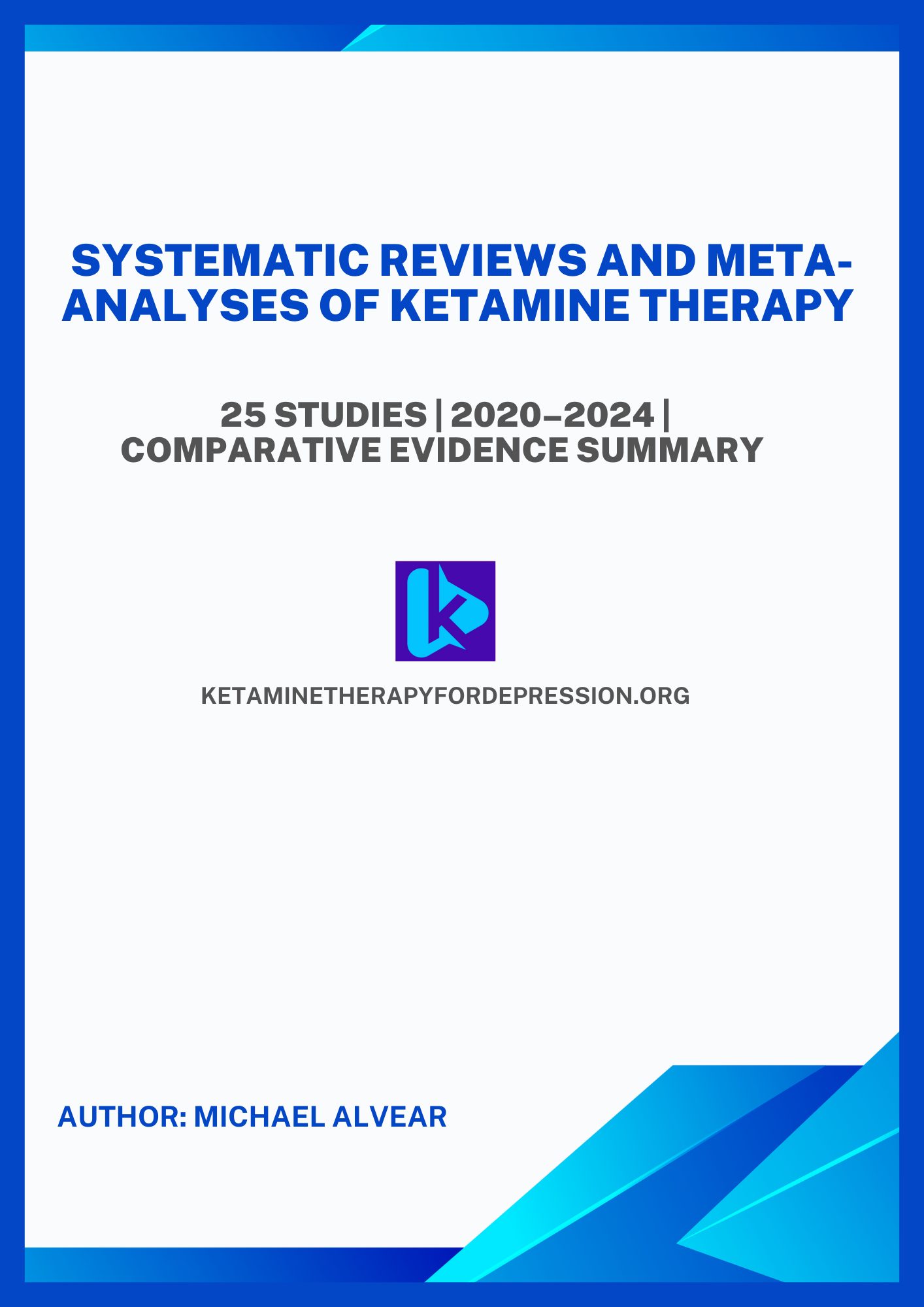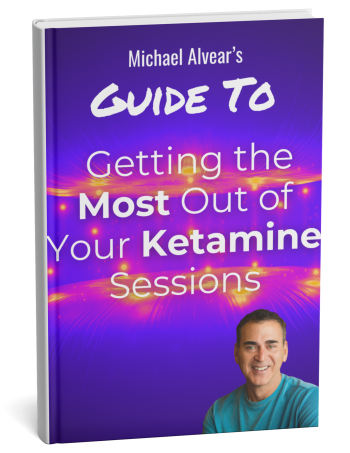Ketamine Therapy for Depression: What It Is, How It Works, Who It Helps, Risks & Costs
By Michael Alvear, Health Author & Independent Researcher
My research is published on these scholarly platforms:
Last Updated:
Ketamine therapy is the medically supervised administration of ketamine (an anesthetic) for treatment-resistant depression and other mental health conditions, delivered via IV, injection, nasal spray, or tablets/troches in specialized clinics.
- Effectiveness decreases as you move from IV → Injections → Spravato → Oral/Sublingual
- Fastest relief (IV/Injections) works 5-80x faster than slowest (Oral) — Hours to days versus 2-6 weeks is a dramatic difference in time to symptom improvement
- Bioavailability drops off a cliff after injections — IV delivers 100%, Injections 93% (only 7% loss), then Spravato plummets to 48%, and Oral crashes to 16-32%
- Only Oral/Sublingual metabolizes into a different, weaker compound — IV/Injections deliver the full racemic ketamine molecule directly to the bloodstream, and Spravato delivers the esketamine molecule (half of racemic) through nasal absorption. Both avoid the metabolic degradation that reduces oral ketamine’s potency
- Spravato has the wildest cost swing — Ranges from as low as $50 per session with insurance + subsidy to $1,050 without insurance, making it either the cheapest or most expensive option depending on coverage
- Insurance only covers the middle option, not best or worst — Spravato (3rd most effective) gets coverage, while the most effective (IV/Injections) and least effective (Oral) both require full out-of-pocket payment
- Only Spravato has FDA-specific depression approval — IV, Injections, and Oral are all “off-label” use of an FDA-approved anesthetic.
- Oral/sublingual is the only route without standardized treatment protocols — Unlike IV/Injections (11-18 sessions typical) or Spravato (rigid 21-session FDA mandate), oral has no professional guidelines on dosing schedules
- Side effects are identical across all routes, but supervision level differs — The clinical routes (IV/Injections/Spravato) all have the same safety profile when supervised, while oral has additional FDA warnings specifically about unsupervised at-home use increasing risks of misuse and dependence
- Only Spravato has insurance coverage, but requires 21 sessions in REMS-certified facilities
- Oral/sublingual offers convenience but lowest effectiveness and FDA safety concerns for at-home use
- Practical burden and effectiveness are inversely correlated — Most effective routes (IV/Injections) have highest burden with transportation, childcare, and 11-18 half-days lost. Least effective (Oral) has lowest burden with no clinic trips
- Spravato requires the most sessions despite middle-tier effectiveness — 21 mandatory sessions (more than IV/Injections’ 11-18) because of rigid FDA protocol, meaning you’re making MORE trips for a LESS effective treatment than IV or injections
- Access restrictions vary dramatically by route — IV/Injections available at most ketamine clinics, Spravato ONLY at REMS-certified facilities (limited locations), Oral available at home via telehealth or in therapy offices
- Oral/Sublingual has three completely different delivery models with vastly different costs — Telehealth “micro” daily dosing ($129/month), telehealth “macro” sessions ($200-500/month), or medication-only through physicians ($75-200 per fill), creating confusion about what you’re actually getting
Your Complete Ketamine Therapy Guide
This comprehensive guide explains what ketamine therapy is, how it works, who qualifies for treatment, what to expect during sessions, and the complete process from consultation to recovery.
Ready to dive in? We’ve organized everything you need to know into 8 comprehensive sections.
↓
Click any card to jump directly to that section
Can’t Decide Between IV, Injections, Or Spravato?
Use My Decision Table

This report ranks all three options—IV, injection, and Spravato—on effectiveness, cost, fastest relief, and more, giving you a clear framework to decide.
Downloads as PDF • 5 minute read
Why watch this video:
- It shows how a single ketamine-induced vision revealed the depth of my self-hatred
- It explains how that vision slowly transformed into a symbol of self-worth
- It captures something talk therapy and SSRIs alone never touched
Click to see transcript
I want to show you how psychedelic visions can help end your depression. I know that sounds over the top—and it is—because the truth is, it takes a lot more than one vision. I should know. I went through ketamine therapy and had dozens. But I credit those visions as the reason I reached remission within six weeks.
When people hear “psychedelic visions,” they think of 1960s acid trips—Timothy Leary, The Electric Kool-Aid Acid Test, floating through space without Jeff Bezos or Elon Musk. But that’s not what they are in a therapeutic setting. In therapy, psychedelic visions are messages from your subconscious, always in the language of metaphor.
I want to tell you about one vision that was instrumental in creating the first green shoots of self-compassion.
Suddenly, I was seized by a vision of a wolf—red glowing eyes, radiating hatred—and it was eating me alive. I could hear my tendons snap and bones break in its jaws. It was horrifying.
Then I had a stunning realization: **I was also the wolf.**
That’s part of the gift of ketamine—dissociation. I could be two things at once: predator and prey. But that moment—the moment I realized I was the one eating myself—I don’t think I could’ve understood the depth of my self-hatred any other way.
Later, in therapy, I asked the wolf, “Why are you eating me?”
It answered: “To survive.”
When I told my therapist, he said, “That’s the most vivid expression of self-hatred I’ve ever heard.” I asked him what to make of the wolf’s answer. He said, “That’s your depression consuming your sense of self. Not out of malice, but as a survival strategy gone wrong. A twisted form of self-protection.”
Then he leaned in and said something I’ll never forget: “Self-hatred can be a desperate grab for control. For safety. A way to numb the pain.”
I asked him, “So… the wolf is eating me so I don’t have to look at what’s really making me depressed?”
He said, “Exactly.”
Later, I tried to engage the wolf again in meditation. It came quickly, but still hostile. At least it wasn’t eating me. I whispered, “There might be more nutritious things to eat than me. Like antelope. Or moose.”
And something shifted. The wolf backed off. It started hunting elsewhere.
Over time, the wolf kept returning in meditation. I wanted to be friends with it. I tried to communicate—not verbally, but… something like telepathy. And one day, it told me: **”I am not your friend.”**
It hurt. I was trying to make peace with this thing. But then I had a final vision. I was in a house, warm, while it snowed outside. The wolf was circling, howling—but this time, I didn’t feel threatened. I felt protected.
And I realized: the wolf was howling to the others, **”Michael’s okay. He’s safe.”**
What I understood was this: I don’t need to be your friend or family to recognize your worth. You are worth protecting. Period.
That’s what I want you to know about psychedelic visions. What started as self-hatred became the beginning of self-worth.
This didn’t cure my depression. It was early in the process. But it started a conversation with myself I never could’ve had through talk therapy or an SSRI.
So no—ketamine doesn’t work for everyone. But it can. And it might. It deserves your attention. And I want to help you figure out whether it’s right for you.
Frequently Asked Questions About Ketamine Therapy
What is ketamine therapy—and what does it feel like physically and mentally?
It’s a low dose of the anesthetic ketamine given through an IV, injection, nasal spray, or tablet by trained professionals in a medical clinic. The dose is high enough to alter consciousness but low enough to avoid losing consciousness. Once the medicine crosses the blood-brain barrier, it creates a powerful dissociative effect.
Physically, you may feel like your body is melting into the chair—weightless, numb, disconnected from pain. For many, chronic aches vanish completely. Mentally, you might feel detached from thoughts or emotions, like an observer watching yourself from afar. Time stretches or collapses. Shapes and colors may bloom behind closed eyes, often forming symbolic or emotionally charged visions.
Roughly half to two-thirds of people experience psychedelic imagery. These aren’t random “trips”—they’re messages from your subconscious. Taken seriously, they can uncover buried trauma, grief, or self-perceptions you didn’t know were holding you back. They’re not the medicine, but they’re part of how the medicine heals.
Why is ketamine therapy done in a clinic—and not at home?
Once ketamine crosses the blood-brain barrier, you lose access to your usual mental and physical faculties. You may be unable to move your arms or speak. Your sense of time collapses. It feels like you mind detaches from your body. In that state, you can’t make decisions or protect yourself—so the clinic does it for you.
Clinics provide containment, not just medicine: a blood pressure check, oxygen monitoring, a recliner, a blanket, a blindfold. You’re not there to stay aware. You’re there to let go.
And if you’re using Spravato, the FDA requires you to take it in a certified clinic under their REMS program. It’s not optional. You must be supervised for two hours after dosing. Sometimes, difficult emotional baggage comes up during treatment. Having trained staff nearby ensures you’re supported—not just physically, but emotionally. You’re not alone in the experience. The clinic is there to keep you safe on every level.
What happens during a ketamine therapy session, and how long does it last?
When you arrive, you’ll fill out a short depression questionnaire so the clinic can track your progress over time. Then a clinician checks your blood pressure and oxygen levels to make sure you’re physically clear to begin.
A few minutes after the ketamine is administered—whether by IV, injection, or the Spravato nasal spray—you’ll enter an altered state that lasts about 40 to 60 minutes. With IV, your blood pressure is continuously monitored. With injection and Spravato, it’s typically checked at the halfway point, since ketamine is known to spike blood pressure.
After the journey ends, you may feel groggy, disoriented, or emotionally raw—which is why clinics build in a recovery period: 20 to 30 minutes for IV or injection, 60 minutes for Spravato (a federal requirement).
Total time for a ketamine therapy session is about 1 hour and 40 minutes for IV/injection, and about 2 hours and 15 minutes for Spravato—roughly 35 minutes longer.
What does ketamine feel like during treatment—physically and psychologically?
A deep, physical relaxation spreads through you. Some people describe their bodies as weightless or hollow, as if they’ve lost mass altogether. Others feel too large, too small, or shaped wrong. Chronic pain often vanishes—back pain, joint pain, even long-term tension can go quiet, like the body’s alarms have been cut. Movement may feel impossible, like you’re fused to the chair.
Dissociation is at the core of the experience. Your sense of self detaches from your physical form. You might feel like you’re floating above yourself, or like the “you” inside your body is gone. Thought loops arise, but they don’t feel like yours. You’re present, but distant.
The visuals can be subtle or surreal: colors, landscapes, symbols, even entire scenes. They can feel meaningful—or terrifying. Fear, awe, confusion—they all surface without warning.
The one through line is disconnection: from your body, from time, from the person you think you are. For some, it’s a relief. For others, it’s disorienting. Often, it’s both.
What percent of people have psychedelic experiences on ketamine, and what are they like?
Roughly 40–50% of patients report psychedelic effects during ketamine treatment. Some see vivid imagery—faces, symbols, entire dreamlike scenes. Others don’t see anything at all. But when visions happen, they can be intense—not like dreams or hallucinations, but like events you’re actually living through.
Psychedelic visions aren’t random “trips”—psychiatrists believe they act as a bridge between your subconscious and conscious mind, offering insights that might otherwise remain out of reach.
Often described as “watching a movie made by your subconscious,” psychedelic visions speak in the language of metaphor, and often require the help of an integration therapist to make sense of. Most researchers believe these visions serve as a portal to parts of the psyche that no conversation, analysis, or traditional therapy could ever reach.
Many patients who reach remission credit their psychedelic visions as instrumental to their healing.
Why do I need someone to drive me home after ketamine treatment, and what happens if I don’t?
Ketamine impairs your coordination, perception, and reaction time, making it unsafe and illegal to drive after treatment. Even after the peak effects fade, your brain is still under the influence. Depth perception is distorted. Reflexes are delayed. Your ability to assess risk and respond to sudden changes—pedestrians, traffic, swerving cars—is significantly reduced.
This isn’t a subtle shift. It’s a measurable impairment that persists for hours.
Many people experience what’s called an “afterglow”—a sense of calm, mild euphoria, or detachment. That emotional quiet can mask just how impaired your body still is. The dissociation that makes ketamine effective is also what makes it dangerous behind the wheel.
If you’re pulled over or in an accident, there’s no legal defense. Ketamine is a dissociative anesthetic, and visible signs of sluggishness or confusion are enough to count as impaired driving. Driving under ketamine isn’t just risky. It meets the legal definition of DUI.
Why is therapy important during ketamine treatment—and what does it actually do?
Therapy is important during ketamine treatment because it helps patients process the emotional material that ketamine brings to the surface. Ketamine often loosens psychological defenses and allows unresolved trauma, grief, or fear to emerge—sometimes suddenly and without context. Therapy provides a structure for working with those moments instead of just moving past them.
During a session, ketamine may trigger memories, symbolic imagery, or intense emotional shifts. These experiences can be disorienting, surreal, or difficult to interpret. Without support, it’s easy to miss their significance or suppress them once the drug wears off. A therapist helps you slow down, sort through what came up, and identify what matters.
This isn’t traditional talk therapy. It’s about integration—making sense of what you saw or felt while under the influence of ketamine. It can also help you track patterns across sessions and notice emotional shifts that aren’t immediately obvious.
Ketamine opens the door. Therapy helps you walk through it with your eyes open. Without it, much of the emotional work risks being lost.
How do I know if I’m a candidate for ketamine therapy, and who shouldn’t get it?
Eligibility depends on the form of ketamine therapy. Spravato is only approved for treatment-resistant depression. IV, injection, and oral ketamine can treat a broader range of diagnoses—including major depression, persistent depressive disorder, bipolar depression, and seasonal affective disorder.
Some medical conditions are automatic disqualifiers because they create immediate life-threatening risks: brain aneurysm, history of brain bleeding, severe heart disease, pregnancy, active psychosis, schizophrenia, or a current suicide plan.
Others are of high concern but might be manageable with proper medical oversight and extra precautions: uncontrolled high blood pressure, recent stroke, severe liver disease, seizures, serious breathing problems, or active substance abuse.
Some conditions might not be ruled out if treatment if they’re well-controlled: mild asthma, thyroid disorders, controlled blood pressure, eating disorders, anxiety, glaucoma, or bladder problems.
Medical eligibility isn’t the only barrier. For example, IV and injection therapy are expensive and entirely self-pay. Spravato is covered by insurance, but still costs around $8,000 out of pocket. And it must be administered in a REMS-certified clinic, which may not exist in your area.
What Does Scientific Research Show About IV Ketamine’s Effectiveness For Depression?

I pulled together 33 systematic reviews from the last five years into one report—so you don’t have to rely on hype, guesses, or anecdotes. This is the highest level of real-world evidence we have.
Inside My Report You’ll Find
- What percent of patients enter remission—broken down by delivery method
- Which method is most effective—IV, injection, or Spravato nasal spray
- How fast ketamine can work to reduce or end symptoms
- Which combinations (like psychotherapy) may enhance response
- And a lot more…
Verified by the Platforms That Matter
This research summary report has been published across four trusted platforms that host peer-reviewed or open science content, including:
– Published ketamine research on Zenodo
– Ketamine evidence summary hosted on SSRN
– Scientific report on ketamine outcomes on Figshare
– Evidence-based ketamine therapy report on OSF
View the PDF Report Here:
Clinical Evidence & Sources for This Page
Research shows IV infusion and intramuscular injections are the most effective treatments, followed by the Spravato nasal spray. Oral/sublingual are least recommended due to unreliable absorption and safety concerns.
NCBI Bookshelf
Mass General Brigham – Ketamine vs Esketamine Study
FDA – Compounded Ketamine Safety Warning
Most ketamine therapy sessions involve about 40–60 minutes of “active” experience, where you’re in an altered state of mind, followed by at least 45 minutes of quiet recovery before you’re cleared to leave. In practice, that works out to roughly 1 hour 40 minutes total for IV or injection sessions and about 2 hours 15 minutes for Spravato, from the start of dosing to walking out of the clinic.
National Library of Medicine – Ketamine Session Parameters
FDA – Spravato Prescribing Information (2025)
National Library of Medicine – Esketamine Dosing & Monitoring
IV ketamine infusion is an off-label treatment for depression in which ketamine is administered slowly through a vein, usually over about 40 minutes, at sub-anesthetic doses (commonly around 0.5 mg/kg). In clinical studies, many patients with treatment-resistant depression experience a rapid reduction in symptoms within hours to days after one or a short series of IV ketamine infusions.
Psychiatry Investigation – IV Ketamine for TRD
VA – Ketamine Infusion for TRD (2022)
VA Community Care – Ketamine Clinical Determination
National Library of Medicine – Ketamine in Mood Disorders
Intramuscular (IM) ketamine for depression is given as a single injection into a large muscle (often the thigh or upper arm), using sub-anesthetic doses similar in range to IV ketamine but delivered all at once instead of by continuous drip. Like IV, IM ketamine has been associated in studies and clinical practice with rapid reductions in depressive symptoms—often within hours to days—but data are more limited, and dosing and monitoring protocols vary by clinic.
Spravato (esketamine) is an FDA-approved nasal spray for treatment-resistant depression and depressive symptoms in adults with major depressive disorder and acute suicidal ideation or behavior, given only in certified clinics under a REMS program with monitoring for at least two hours after each dose. It’s typically used together with an oral antidepressant, following a front-loaded schedule (twice weekly at first, then tapered), and can cause side effects like dissociation, dizziness, increased blood pressure, and sedation, which is why patients cannot drive themselves home after treatment.
Oral and sublingual ketamine for depression are off-label formulations (often compounded lozenges or tablets) taken by mouth or dissolved under the tongue, usually at sub-anesthetic doses given on a repeated schedule determined by the prescriber or clinic. Early studies and clinical experience suggest they can reduce depressive symptoms for some patients, but the evidence base is smaller and lower quality than for IV ketamine or Spravato, and major regulators like the FDA have warned about safety risks when these products are used at home without proper medical supervision.
Dissociation during ketamine therapy is a temporary change in perception and awareness—people often describe feeling “spaced out,” detached from their body, or as if things around them aren’t fully real. It usually begins within minutes of dosing, peaks during the infusion or shortly after dosing, and then fades over 30–120 minutes; clinics monitor patients closely during this period and generally do not let them drive or leave unsupervised until the effects resolve.
Spravato (esketamine) is a Schedule III controlled substance that was approved by FDA in 2019 as a nasal spray for treatment-resistant depression in adults and depressive symptoms in adults with major depressive disorder with acute suicidal ideation or behavior, in conjunction with an oral antidepressant. Because of the potential risks associated with Spravato (esketamine), including sedation, dissociation, and abuse or misuse, its label FDA contains Boxed Warnings, and Spravato is subject to strict safety controls on dispensing and administration under a safety program called a Risk Evaluation and Mitigation Strategy (REMS). The Spravato REMS program requires Spravato (esketamine) to be dispensed and administered in health care settings that are certified in the REMS. Patients must be monitored inside the healthcare setting after administration for a minimum of two hours until patients are safe to leave.
Drugs.com – Spravato History & Approval
DailyMed – Spravato Label
Florida Blue – Spravato Medical Policy
Psychedelic-like visions during ketamine therapy can include vivid colors, geometric patterns, dreamlike scenes, or emotionally charged “movie clips” from one’s life, often experienced with eyes closed and a sense of altered time or self. Not everyone gets these visions, but when they do occur they’re usually dose-dependent, peak during the active phase of the session, and fade as the drug wears off; clinics generally prepare patients in advance and monitor them closely so the experience stays physically safe even if it feels intense or strange.
American Psychological Association – Psychedelics as Medicine
IV ketamine infusion sessions usually involve about 40 minutes of actual infusion time, plus pre- and post-treatment checks, so most patients are in the clinic for roughly 1.5 to 2 hours total. By contrast, a Spravato (esketamine) nasal spray session involves a short self-administered dosing period but requires at least 2 hours of mandatory observation under the REMS program, so clinic visits typically run about 2 to 3 hours from check-in to discharge.
Spravato HCP – REMS Requirements
Journal of Clinical Psychiatry – Ketamine Dosing & Duration
You need a driver after ketamine therapy because the drug can leave you sedated, dissociated, dizzy, and slower to react for several hours, even after you “feel fine,” which makes driving or using public transportation unsafe. For REMS-regulated Spravato and for most IV or injection protocols, clinics treat you as impaired until the effects fully wear off and typically require that a trusted adult picks you up and stays responsible for you afterward.
A therapist can make ketamine work more effectively by helping you set goals before sessions, stay grounded during the experience, and then “integrate” what came up into concrete changes in your thoughts, habits, and relationships afterward. Early research and clinical practice suggest that combining ketamine with structured psychotherapy (for example CBT, ACT, or trauma-focused work) may extend the antidepressant benefits and reduce relapse compared with doing medication alone.






